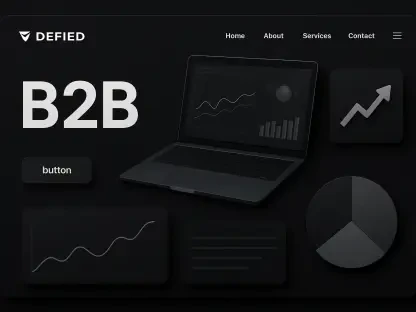For years, B2B marketers have treated digital as a funnel – a pipeline engineered for efficient lead capture, qualification, and conversion. The playbook was predictable: attract, nurture, convert, repeat. However, in today’s buyer landscape, characterized by hyper-informed audiences, fragmented touchpoints, and dwindling patience, lead generation alone is no longer sufficient.
B2B digital marketing is evolving into something broader, more intuitive, and ultimately, more human: experience marketing. This new paradigm recognizes that buyers don’t just want to be converted – they want to be understood.
Read on to learn why buyers no longer respond to being sold to, and see how you can move from lead gen to experience marketing.
The Problem with the Funnel
The traditional funnel assumes a linear journey: awareness leads to interest, interest to consideration, and so on. But real buyers don’t move that way anymore.
B2B buyers now engage with digital interactions before making a purchase. These interactions happen across multiple platforms – social, search, communities, review sites – and rarely follow a neat sequence.
In this complex environment, the friction between what marketers deliver and what buyers expect becomes visible. The more marketers push content designed purely to capture leads, the more audiences tune out.
Buyers no longer respond to being sold to; they respond to being seen. And that shift is forcing B2B digital marketing to move past its performance-obsessed roots and into something more experiential.
From Transactions to Trust
Experience marketing flips the script: it treats every digital touchpoint not as a transaction, but as a moment of trust.
The goal isn’t just to collect form fills – it’s to build emotional equity. That means prioritizing brand experiences that feel consistent, contextual, and customer-first, even when they’re automated.
For example, rather than sending a cold email offering an eBook, brands are designing immersive content ecosystems where insights, visuals, and interactivity reinforce one another. A well-executed webinar might extend into a dynamic follow-up hub, where attendees can explore case studies, demos, or Q&A clips tailored to their role or industry.
It’s marketing that feels like it’s meeting you where you are, not dragging you through a lead gen pipeline.
The Experience Economy Comes to B2B
For years, consumer marketing has thrived in the experience economy – think Apple’s seamless unboxing or Nike’s community-driven fitness ecosystem. Now, B2B brands are catching up.
The reason is simple: today’s B2B buyers are the same people who expect personalized, frictionless, and emotionally resonant experiences as consumers. When they log into a webinar or click a display ad, they don’t leave those expectations at the door.
B2B marketing is finally recognizing that emotional differentiation drives rational decision-making.
Data, Design, and the Digital Thread
The move toward experience marketing isn’t about abandoning analytics – it’s about using data to humanize engagement.
The most advanced B2B marketers are weaving a digital thread through their ecosystems, linking content, campaigns, and interactions into a single view of the buyer’s journey. This creates feedback loops that power real-time personalization: the kind that anticipates needs rather than reacting to them.
For instance, AI-driven platforms can interpret intent signals from a visitor’s content path – say, white paper downloads or webinar drop-off points – and dynamically tailor the next experience. Instead of gating every asset, marketers can invite deeper exploration and reward curiosity. The result? A buyer who feels recognized, not tracked.
Content as an Experience Layer
If digital is the stage, content is the set design. But in experience marketing, content does more than inform – it immerses.
Interactive infographics, modular videos, and dynamic microsites are becoming the new backbone of storytelling. They allow B2B brands to demonstrate authority while encouraging participation.
For example, a static “industry trends” report might evolve into a self-guided exploration tool, where readers filter data relevant to their business. Or a customer success story becomes an interactive timeline that lets users explore milestones by theme or outcome.
These aren’t gimmicks – they’re part of a strategy that shifts the value exchange from “give me your data” to “let me give you a better experience.”
The Human Element Returns
Ironically, as marketing becomes more digitized, the need for human connection grows.
Experience marketing is not about more automation; it’s about better empathy. B2B buyers expect brands to understand their challenges, the context in which they operate, and their intended goals. That’s why tone, language, and authenticity matter more than ever.
Marketers who speak with their audience rather than at them earn credibility faster. In a noisy market, clarity and warmth become differentiators. The most successful digital experiences now combine human tone with intelligent technology – an AI chatbot that speaks like a consultant, or a product video narrated by real users rather than actors.
Metrics That Matter
The pivot to experience marketing also requires a new mindset for measurement.
Traditional KPIs – such as form fills, click-through rates, and MQLs – still matter, but they tell only part of the story. Experience metrics, such as content engagement depth, dwell time, repeat interactions, and post-conversion satisfaction, provide richer insights into the strength of long-term relationships.
In other words, marketers must start tracking how their audience feels, not just what they do.
The goal is not volume – it’s velocity and value. Experience-led marketing converts because it nurtures affinity first and intent second.
Experience Is the New Differentiator
In markets crowded with lookalike products and parity pricing, experience becomes the moat.
A prospect who feels frictionless engagement, coherent messaging, and value in every click is more likely to convert – and stay loyal. Experience marketing doesn’t replace lead gen; it elevates it. The two are not opposites, but evolutions of each other.
When a brand earns the right to guide a buyer’s journey, lead generation becomes a byproduct of trust.
Building the Experience-First B2B Organization
Moving from lead gen to experience marketing is not a campaign tweak; it’s a cultural shift.
It requires collaboration between marketing, sales, design, and product teams to align on a shared north star: delivering cohesive, contextual experiences at every touchpoint. That means:
Rethinking KPIs to include brand experience metrics
Investing in platforms that integrate content, data, and personalization
Upskilling teams in UX design and behavioral psychology
And above all, nurturing a mindset where experience is everyone’s job
When organizations make that shift, marketing stops being a cost center and becomes a growth engine – one powered by connection.
The Future of B2B Marketing Is Felt
As B2B digital marketing matures, the winners won’t be those who automate fastest or gate the hardest. They’ll be the ones who design experiences that feel effortless, intelligent, and human.
Because beyond lead generation lies something far more valuable: brand experiences that people remember – and return to.









